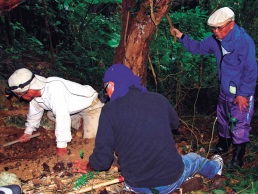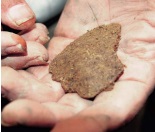Man finally finds remains of sister killed during Battle of Okinawa

Battle of Okinawa survivor Shigeru Hoshikado (far right) watches volunteers who look for his sister’s remains on May 3 in Arashiro in the town of Yaese.
May 5, 2015 Reiko Akamine of Ryukyu Shimpo
Battle of Okinawa survivor Shigeru Hoshikado, 84, of Urasoe city, on May 3 successfully located what is believed to be the remains of his younger sister, with the help of a volunteer group dedicated to recovering the remains of the war dead. His sister Setsuko was killed during the Battle of Okinawa.
Hoshikado said locating Setsuko’s remains has been his objective since the end of the war. His wish finally came true on the 70th anniversary of the 1945 battle. The remains were found on a mountain in Arashiro in the town of Yaese.
It was also the first time for the volunteer group Gamafuya to search for the remains of a specific individual in response to a request from a bereaved family.
“Secchan, I am sorry I couldn’t welcome you for a long time,” Hoshikado said tenderly as he carefully held a tiny piece of his sister’s skull in his hands.

A piece of a child’s skull discovered by the volunteer group Gamafuya on May 3 in Arashiro in the town of Yaese.
During the battle, Hoshikado lost his grandmother, father, brother, as well as his sister. Setsuko, who was 6 at the time, died instantly when she was hit by a bullet in a cave in Arashiro in Yaese. Hoshikado, who was 14 at the time, buried her under a rock near the cave.
Other members of Hoshikado’s family died at different locations but their remains were all recovered shortly after the war. Though his mother was always telling him to “be sure to recover” her remains, Hoshikado had not been able to locate them due to difficulties accessing the mountain, which is densely covered by vegetation.
“My heart had been unsettled for the entire time after the war, I felt like my sister was calling me, saying ‘ni ni’ (brother),” Hoshikado said, speaking in Okinawan dialect. “Every time I saw my grandchild, I thought about Setsuko,” he said.
As the battle marked its 70th anniversary this year, Hoshikado became aware of the work of Gamafuya through a newspaper article and contacted its leader Takamatsu Gushiken for help. A group of students who study with Yoshihito Sudo, an associate professor at Okinawa University, also took part in the search.
The volunteers searched the area a total of four times starting on April 19 based on Hoshikado’s recollections. He said there were three caves that his family had used as evacuation shelters located on the right side of a river as one headed downstream. The river had a bridge over it and he buried his sister beneath a large rock on the opposite bank.
The volunteers waded through bushes and climbed slopes with a rope before finally finding a place that matched his description on the third day. Based on the position of the caves and the rock, Hoshikado said he was convinced “this must be it.”
The search for the remains, conducted on the fourth day, took about five hours. Just as the participants were about to give up, a piece of a child’s skull appeared on the surface, according to Hoshikado.
“This shows what we can do — we were able to locate the remains of a war dead based on the recollections of a bereaved family member. We will continue to look for the rest of her remains,” said Gushiken, the group’s leader.
“Finally, I can tell my parents in heaven (that the remains were recovered.) It has taken a load off my mind. I would like to inter the remains at our ancestral grave,” Hoshikado said, gently putting his hand over the piece of skull.
(English translation by T&CT and Miwa Murphy)
Previous Article:Naha Harii dragon boat race
Next Article:Okinawa Governor to visit US to voice opposition to Henoko relocation plan
[Similar Articles]
- Woman claims to be the iconic “trembling girl” in war footage
- “Respect the War Dead” Gushiken’s Hunger Strike in Front of Yasukuni Shrine on Memorial Day for the End of the War Draws Attention to the Issue of War Dead Remains at Okinawan Battleground
- Second-generation Okinawan descendant meets with her mother’s relatives in Okinawa
- DNA testing identifies Japanese soldier killed in Battle of Okinawa
- Three remains from the Battle of Okinawa found in Nishihara
 Webcam(Kokusai Street)
Webcam(Kokusai Street)


